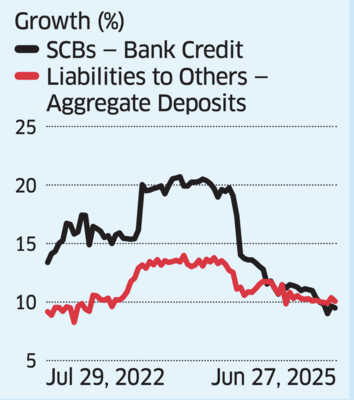India’s banking system loan growth stood at 9.4% as of June 27, its lowest level since March 2022, after having peaked at 2.74% in the current cycle in December 2023. That said, deposits growth now stands at 10%, exceeding loan demand.
Deposit growth had peaked at 14.04% mid-December 2023. For a greater part of FY25, banks were chasing deposits with special schemes, as deposit accretion failed to match credit demand. Now, despite a reduction in the policy rate of 100 basis points to 5.50%, along with a cut in the cash reserve ratio (CRR) in phases, demand for credit has slowed while deposit growth has gathered pace.
 One basis point is a hundredth of a percentage point. The reduction in policy rate has led to transmission of rates to end users, but only partially. The full passthrough will take some more quarters, several bankers said, while announcing the fi rst quarter results. Central bank data showed that about 25-basispoint worth of transmission has taken place on loans while fi xed deposit rates have been reduced in the range of 30-70 basis points since February 2025.
One basis point is a hundredth of a percentage point. The reduction in policy rate has led to transmission of rates to end users, but only partially. The full passthrough will take some more quarters, several bankers said, while announcing the fi rst quarter results. Central bank data showed that about 25-basispoint worth of transmission has taken place on loans while fi xed deposit rates have been reduced in the range of 30-70 basis points since February 2025.
Credit growth may remain weak unless structural reforms in tariff rates and production are taken to boost investments and exports. “There is space for a new producer and exporter of mid-tech goods. India can embrace this opportunity with its abundant labour and wage cost advantage,” said Pranjul Bhandari, chief India economist, HSBC. “But to do this, we believe it needs the right reforms – lower tariff rates on intermediary inputs, more trade deals with other economies, more openness to FDI infl ows, and more ease of doing business reforms across states.”
Deposit growth had peaked at 14.04% mid-December 2023. For a greater part of FY25, banks were chasing deposits with special schemes, as deposit accretion failed to match credit demand. Now, despite a reduction in the policy rate of 100 basis points to 5.50%, along with a cut in the cash reserve ratio (CRR) in phases, demand for credit has slowed while deposit growth has gathered pace.
Credit growth may remain weak unless structural reforms in tariff rates and production are taken to boost investments and exports. “There is space for a new producer and exporter of mid-tech goods. India can embrace this opportunity with its abundant labour and wage cost advantage,” said Pranjul Bhandari, chief India economist, HSBC. “But to do this, we believe it needs the right reforms – lower tariff rates on intermediary inputs, more trade deals with other economies, more openness to FDI infl ows, and more ease of doing business reforms across states.”
You may also like

Rory McIlroy makes Scottie Scheffler claim after Open triumph with Tiger Woods comparison

Michelle Keegan stuns fans with bikini snaps just months after giving birth

Ellen DeGeneres reveals why she really left United States as she gives UK home update

Jeremy Clarkson left completely confused over farm issue as he reveals 'most difficult thing'

Paul Gascoigne rushed to intensive care after being found collapsed at home







